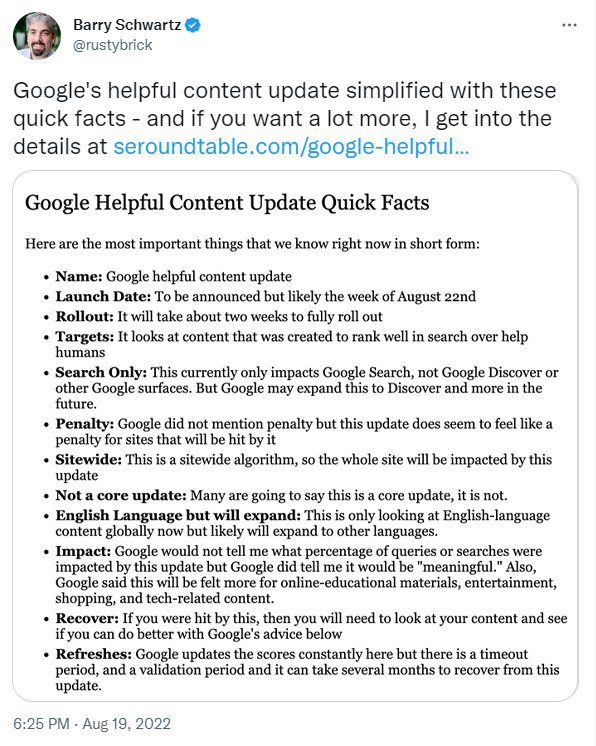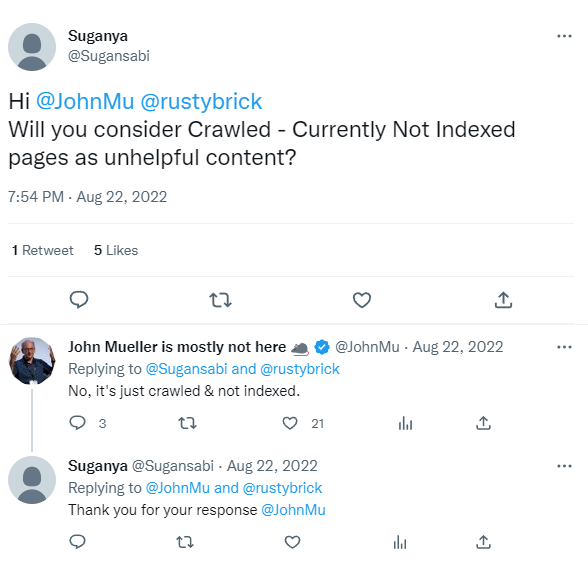Google’s Helpful Content Update includes changes to the way that Google evaluates and ranks content, as well as new features and capabilities that are added to the search algorithm.Google’s algorithm is designed to provide users with the most relevant and useful information for their search queries. As part of this effort, Google periodically makes updates to its algorithm to improve the quality and relevance of the content that is returned in search results.
The recent Google’s Helpful Content Update that was introduced in December 2022 is expected to fundamentally alter the way we produce content!
Google’s Latest Update that the creators should know about
How often have you searched for a query or topic on Google and had to click on multiple links before finding what you were looking for? Or perhaps the information was never discovered at all.
In an effort to address this issue, Google recently updated its helpful content on December 2022. Google’s Helpful Content Update intends to remove articles with high rankings but no substance. In order to provide users with a more gratifying experience, it is important to better match them with excellent content.
The algorithm creates a site-wide signal, which Google’s Helpful Content Update takes into account in addition to many other signals when ranking web pages. The computers automatically recognise content that appears to be of minimal value, has no added value or is simply not very useful to users conducting searches.
Google is targeting content that is lacking in knowledge, authority, or credibility. Having been written with search engines in mind, search engine-first content may perform well in SERPs and receive a lot of search traffic. The user, however, is left wanting more and is compelled to keep clicking because it doesn’t provide a response to their query.
The Google Helpful Content Update started using a site-wide ranking signal to put the new upgrade into effect. Sites with unhelpful content are categorised in this way. This update is ongoing to include both current and new websites; it doesn’t refresh every now and then. Machine learning is the model used by the automated process.

Why is the Helpful Content Update important for the users?
Your website won’t perform well in search results if Google’s classifier determines it has a lot of unhelpful content. Even if your website contains some useful content, it is considered irrelevant. Every piece of content on your website is impacted by the categorisation. With every piece of content, Google encourages writers to put readers before search engines. The search engine intends to provide more high-quality results that live up to user expectations by setting this criterion.
More emphasis on People-First Content
In order to better ensure that users receive unique, practical material created by people, for people, in search results, Google Search’s helpful content system produces a signal that is used by our automated ranking systems. More information regarding the system’s operation and what you can do to evaluate and enhance your content is provided on this page.
The helpful content upgrade attempts to better reward content where users believe they have had a pleasant experience; conversely, content that falls short of a user’s expectations will not do as well.
How can one prepare for the Update?
There’s nothing to worry about if the information you’ve been producing is considerate and beneficial. The Google Helpful Content upgrade will only remove unfair competition or websites that have been employing unethical tactics to outrank you.
Content that is useful and reliable puts its readers ahead of search engines. However, it does not imply giving up on your SEO best practices. To increase the likelihood that searchers will locate your content, SEO is still necessary.
1. Identify and know your Target Audience

Google Question: “Do you have a target market for your company or website that would be interested in the content if they visited you directly?”
A common SEO strategy should include defining your target market. Google has warned you if you haven’t been writing with a specific audience in mind. Keep in mind that Google wants you to develop informative content.
To define your target audience for Google’s helpful content update, you should consider the following:
- Demographics: Who are your ideal customers in terms of age, gender, income, education, and location?
- Interests: What are the interests and needs of your target audience? What kind of content do they typically consume?
- Goals: What are the goals of your target audience? What do they hope to achieve by visiting your website?
- Behaviour: How do your target audience typically consume content? Are they mostly mobile users, or do they prefer desktop? Do they prefer long-form content or shorter snippets?
By considering these factors, you can create content that is tailored to the specific needs and preferences of your target audience. This will increase the chances that your content will be considered “helpful” by Google and boost your search rankings.
2. Eyes on the lane
Google Question: “Will a reader believe they have learned enough from your content to assist them to accomplish their objective after reading it?”
Maintain your lane. Focus on your area of expertise and the interests of your clients. Avoid writing about subjects you don’t understand or that aren’t relevant to your readers.
Plagiarised content should not be used. You must provide readers with new perspectives and ideas in each post or page if you want to rank highly in the Google SERPs. To support your arguments, collect original data and provide previously unpublished expert quotes. Moreover, make original screenshots and pictures that have never been published on another page.
3. Lay emphasis on the search query
Google Question: “At times when some sites promise certain things and catfish others by providing clickbait, how does one avoid that?”

Provide the user with the information that they require. Unravel their enigma. Useless clickbait that promises an answer should not be used.
Google’s Helpful Content Update aims to promote “helpful and informative” content in its search results, and to demote “deceptive, misleading, and manipulative” content, which includes clickbait. To avoid clickbait according to this update, it is recommended to:
- Be transparent about the content of the article before a user clicks through.
- Avoid using sensational headlines that are not representative of the content of the article.
- Use accurate and descriptive headlines that match the content of the article.
- Provide meaningful information to the user, and avoid using misleading or manipulative tactics to drive traffic to your site.
By following these guidelines, you can help ensure that your content is seen as helpful and informative by Google, and is more likely to be promoted in its search results.
4. Step up your expertise
Google Question: “Do you clearly show first-hand experience and depth of understanding in your content (for instance, information derived from having actually used a product or service or visited a location)?”
Create content that enables you to share original research and professional judgement. Think about unique industry knowledge that you or your company can provide to customers and make maximum use of.
To step up your expertise according to Google’s helpful content update, you should focus on creating high-quality, informative, and useful content that addresses the needs and questions of your target audience. This includes:
- Conducting thorough research on the topics you plan to cover, to ensure that your content is accurate and up-to-date.
- Using a clear and concise writing style that is easy to understand and follow.
- Incorporating visuals, such as images and videos, to supplement your text and make your content more engaging.
- Optimising your content for search engines by using relevant keywords and meta tags, and by ensuring that your website is mobile-friendly and loads quickly.
- Staying active on social media and other platforms to promote your content and engage with your audience.
- Continuously monitoring and evaluating the performance of your content and making improvements as necessary.
It’s also important to note that Google’s E-E-A-T (Experience, Expertise, Authoritativeness, Trustworthiness) guidelines are also important to focus on, to make sure that your content is well-cited, from a reputable source, and written by an author with the appropriate level of knowledge and background.
The word “experience” has been included to emphasise that the level of the content creator’s first-hand knowledge of the subject can also be used to judge the quality of the information.
How does one distinguish between Helpful and Unhelpful Content?
Helpful content offers value and fulfills user curiosity. It is unique and wasn’t assembled from several sources. Unhelpful content simply repeats what has already been said. It lacks a point of view or distinctive viewpoint and leaves blanks for the user to fill in. You have two options if the content present on your website is unhelpful or doesn’t match search intent: you can either make it better or remove it. Either move reduces the likelihood that Google will categorise your website and give your content a lower ranking.
AI-generated content appears to be a major issue that Google is attempting to solve. According to Google, AI material violates the Webmaster Guidelines because it is on par with spam content in terms of quality. This is probably because so many websites publish material solely for the aim of site monetization by aggregating spam or artificial intelligence-generated content.

So how does one gauge out unhelpful content out of the picture? People-first content creators prioritise producing engaging content first while incorporating SEO best practices to provide searchers with more relevant results.
Evaluation of content goes beyond organic search success. A page may be beneficial even if it doesn’t generate organic traffic. Too many content audits concentrate on a particular channel (organic) or content marketing objective (acquisition), which results in recommendations that are not appropriate.
If you can affirm the following statements, you are likely using a people-first strategy. To determine whether you can make unhelpful information more effective, use Google’s queries.
- Adding first-hand knowledge
- filling informational gaps
- demonstrating a breadth of knowledge
- relating the article to the main theme of your website
A six-month ban on a page won’t work because Google’s new site-wide signal constantly scans for unhelpful content. Future search results will have more unhelpful information.
Highlights of further helpful content updates
- The upgrade, according to Google testing, produces better results for online learning, arts and entertainment, retail, and tech-related material.
- The update mostly affects international English searches. As a result, multilingual websites might have an advantage in terms of updating or eliminating useless content.
- The search engine disapproves of heavy automation. However, it doesn’t follow that you can’t employ artificial intelligence (AI) to help with some of your writing.
- You shouldn’t rely on Google to inform you which URLs on your website are useless.
- The Google helpful content update first affects English searches all over the world, and it plans to provide support for more languages in the future. Google also plans to make more improvements to the classifier’s ability to identify problematic content over the coming months and introduce new initiatives to better recognise content that puts people first.
It’s crucial to always keep your audience in mind when producing content. Create material that addresses issues close to their hearts and offers them the worthwhile knowledge they want.
Nevertheless, you should make sure that your content is SEO-friendly without going excessive. You might effortlessly incorporate keywords into your page’s text, optimise your headings and title tags, and offer a wonderful user experience.
The Google Helpful Content Update, in the end, is a change that may have a big impact on how search engines perceive your website. If your website isn’t already optimised for the upgrade, you risk not being perceived as “useful” by your target market and losing visitors (and potential clients!) as a result. However, you can still enhance your SEO and achieve success online by making sure that your material is of a high calibre and relevance.
